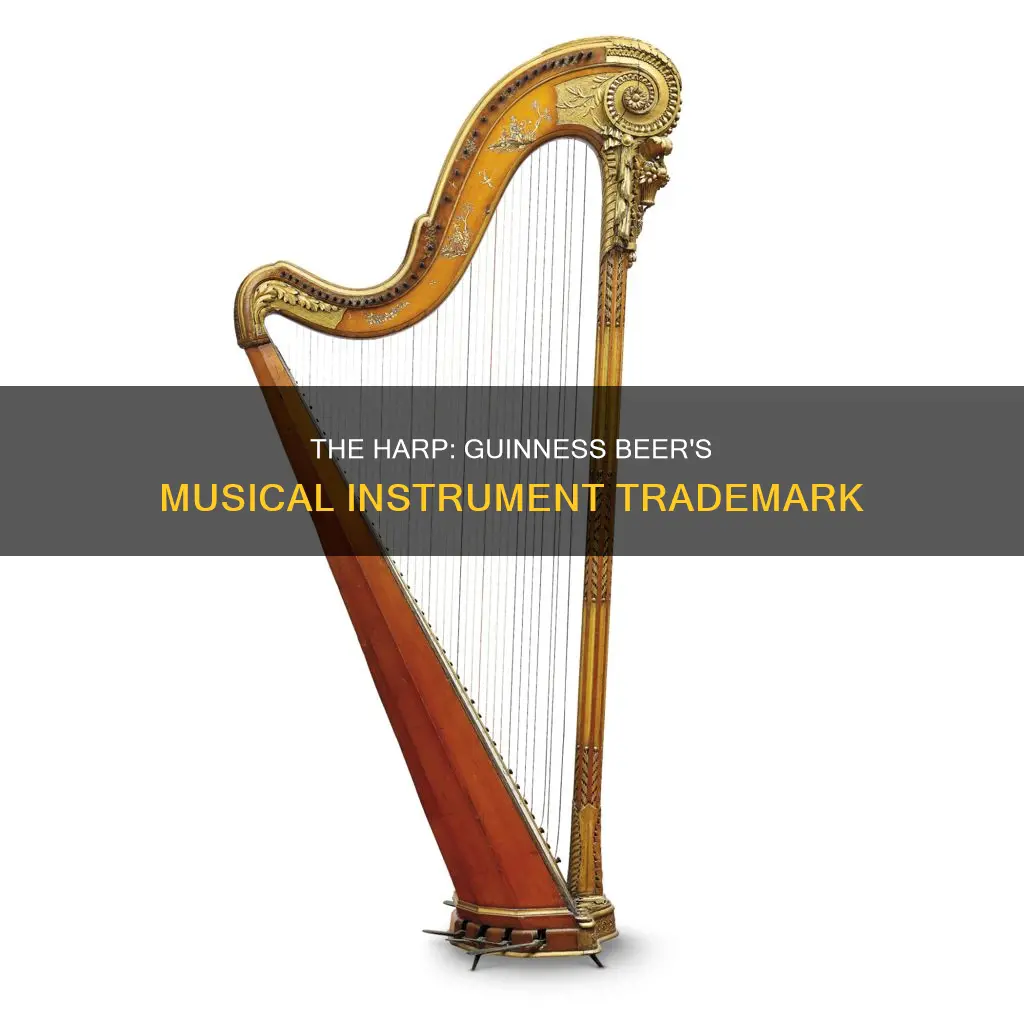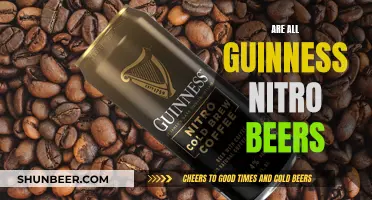
The harp, a symbol of Ireland since the 16th century, has been linked with Guinness since 1862, when it was used as an emblem on its first bottle. The harp emblem on Guinness beer is based on a famous 14th-century Irish harp known as the O'Neill or Brian Boru harp, which is now preserved in the Library of Trinity College Dublin.
| Characteristics | Values |
|---|---|
| Instrument | Harp |
| Harp Type | "O'Neill" or "Brian Boru" harp |
| Origin | 14th-century Ireland |
| Current Location | Library of Trinity College Dublin |
| Symbolism | Emblem of Guinness; Symbol of Ireland |
| Link to Guinness | Used on first Guinness bottle in 1862; Registered as a Guinness corporate trademark in 1876; Guinness lager "Harp" named after the instrument in 1960 |
What You'll Learn

The harp is Guinness' emblem
The harp has long been a symbol of Ireland and its rich cultural heritage. The choice of the harp as the emblem for Guinness is a nod to the company's Irish roots and has helped establish a strong connection with its target audience, particularly in the Irish market. The harp has become synonymous with the brand and is instantly recognisable to consumers, even appearing in the name of their first lager, "Harp", launched in 1960.
The "O'Neill" or "Brian Boru" harp is a significant cultural artefact in Ireland, and its use as the basis for the Guinness emblem adds a layer of authenticity and heritage to the brand. The harp is known for its elegant shape and distinctive sound, and these qualities are reflected in the design of the Guinness logo, which has undergone several redesigns while retaining the core elements of the original.
The use of the harp as an emblem on Guinness bottles and branding has been a successful strategy for the company, helping to establish a strong and differentiated brand identity. The harp emblem has become an iconic symbol, not just for the company but also for Ireland as a whole, with its appearance on Guinness products serving as a source of national pride for many Irish people.
The harp, as the Guinness emblem, has stood the test of time and remains a powerful symbol of the brand's heritage and quality. Its association with Ireland and Irish culture has contributed to the brand's success and recognition worldwide, solidifying its place as an enduring icon in the history of product branding and design.
Guinness Beer: High-Fructose Corn Syrup Content Explored
You may want to see also

The harp symbol is based on the O'Neill or Brian Boru harp
The harp, or cláirseach, has been a symbol of Ireland since the 16th century. Harps have been present in Ireland for over a thousand years, appearing on manuscripts and Christian stone crosses since the 8th century. The harp symbol on Guinness beer is based on the O'Neill or Brian Boru harp, also known as the Trinity College harp. This is a medieval musical instrument dated to the 14th or 15th century, making it one of the oldest surviving medieval harps from the region. It is intricately ornamented and skilfully constructed, likely for a member of an important family.
The O'Neill or Brian Boru harp is currently preserved in the Library of Trinity College Dublin. It was donated to the college in 1782 by Colonel Burton Conyngham, who received it from Chevalier Thomas O'Gorman. The harp was reportedly once owned by Brian Boru, the High King of Ireland, but this claim has been disputed. The instrument bears the coat of arms of the O'Neills, and its history is shrouded in uncertainty, with various theories about its ownership over the centuries.
The harp symbol has been associated with Guinness since 1862 when it was first used as an emblem on its bottles. The design was inspired by the O'Neill or Brian Boru harp, and it has been a registered trademark of Guinness since 1876. The harp symbol has been redesigned over the years, but it retains a strong resemblance to its original version. In 1960, Guinness even named its first lager "Harp," further emphasising the connection between the brand and this iconic musical instrument.
The harp symbol on Guinness beer, derived from the O'Neill or Brian Boru harp, is not just a logo but a representation of Ireland's rich cultural and musical heritage. It serves as a reminder of the country's long association with the harp and reinforces Guinness's connection to its Irish roots.
Guinness: Beer or Lager? Understanding the Dark Irish Drink
You may want to see also

The harp has been a symbol of Ireland since the 16th century
The harp's status as a symbol of Ireland was further solidified in 1541 when Henry VIII declared himself King of Ireland and introduced a unique coinage featuring a harp topped with a crown. The harp has also been linked with Irish nationalism and resistance against British rule, particularly in the 18th and 19th centuries.
The instrument has been an integral part of Irish culture and history, with ancient Gaelic society chieftains travelling with a bard and a harper. Harpers were highly skilled and valued, often studying for decades to perfect their craft. The harp was also a prominent feature in Irish folklore and mythology, with figures such as the blind harpist, Turlough O'Carolan, composing memorable melodies.
The harp's significance continued to evolve, and in 1862, it became associated with the Guinness brewery when it was featured on the label of its first bottle. The design was based on the famous 14th-century "O'Neill" or "Brian Boru" harp, now preserved in the Library of Trinity College Dublin. Guinness trademarked the symbol in 1876, and even named its first lager "Harp" in 1960, solidifying the instrument's connection with the brand.
Today, the harp remains an enduring symbol of Ireland, featured on coins, passports, and official seals, as well as in traditional Irish music and performances. It is a unique emblem, as Ireland is the only country in the world with a musical instrument as its national symbol.
Guinness Beer Ingredients: A Magical Brew's Secret
You may want to see also

Guinness has used the harp since 1862
Guinness has used the harp as its emblem since 1862 when it featured on the first bottle of the beer. The harp design is based on a famous 14th-century Irish harp known as the "O'Neill" or "Brian Boru" harp, which is now preserved in the Library of Trinity College Dublin. Harps have been a symbol of Ireland since the 16th century, so it's a fitting emblem for the famous Irish beer.
The harp emblem has been a part of Guinness's identity for well over a century now, and it was registered as a corporate trademark in 1876. The logo has been redesigned several times but always retains the iconic harp. In 1960, Guinness even launched a lager called "Harp", emphasising the instrument's significance to the brand.
The harp has become an instantly recognisable symbol on Guinness products and merchandise worldwide. It adorns not just the bottles and cans of Guinness but also promotional items such as glasses, bar towels, and signage. The harp logo has become an integral part of the brand's visual identity and a powerful symbol of Ireland's rich cultural heritage.
The choice of the harp as the emblem for Guinness is a nod to the country's musical and cultural traditions. The harp is a stringed instrument with a distinctive shape, and its graceful curves and elegant form have been captured in the Guinness logo. The harp's association with Guinness has contributed to its enduring popularity and ensured its place as an iconic symbol of Ireland.
The harp on the Guinness label is not just a decorative element but a testament to the brand's long history and deep roots in Irish culture. It serves as a constant reminder of the brand's heritage and its connection to Ireland, where the drink has been brewed for centuries. The harp has become synonymous with Guinness and remains an enduring symbol of the brand's quality and tradition.
Guinness Beer Pasteurization: A Process Overview
You may want to see also

The harp was registered as a Guinness trademark in 1876
The harp, a famous 14th-century Irish instrument, has been synonymous with Guinness since 1862. That year, the harp was used as a symbol on the first bottle label for Guinness. The harp was later registered as a Guinness corporate trademark in 1876.
The harp on the Guinness label is based on a 14th-century Irish harp known as the "O'Neill" or "Brian Boru" harp. This harp is now preserved in the Library of Trinity College Dublin and is one of only three remaining medieval Irish harps. The harp has been a symbol of Ireland since the 16th century.
In 1862, Arthur Guinness decided to use an image of the Boru/O'Neill harp on his trademark label, in addition to the other two iconic Guinness devices: the "Guinness" name and Arthur Guinness' signature. By legally registering the harp symbol in 1876, Guinness established its association with this instrument and differentiated itself from other beer brands.
The registration of the harp trademark in 1876 had a significant impact on both Guinness and Irish culture. In 1960, Guinness named its first lager "Harp", clearly linking the brand to the harp symbol. Additionally, when the Irish Free State Government chose the Boru/O'Neill harp as its official emblem in 1922, they had to reverse the orientation of their harp symbol due to Guinness' trademark. This clever solution allowed the Irish government to use a similar harp while creating a legally distinct trademark.
Guinness and Breastfeeding: To Pump or Not?
You may want to see also
Frequently asked questions
A harp, based on the famous 14th-century Irish harp known as the "O'Neill" or "Brian Boru" harp, which is now preserved in the Library of Trinity College Dublin.
The harp has been linked with Guinness since 1862 when it was used as an emblem on its first bottle.
Harps have been a symbol of Ireland since the 16th century.







